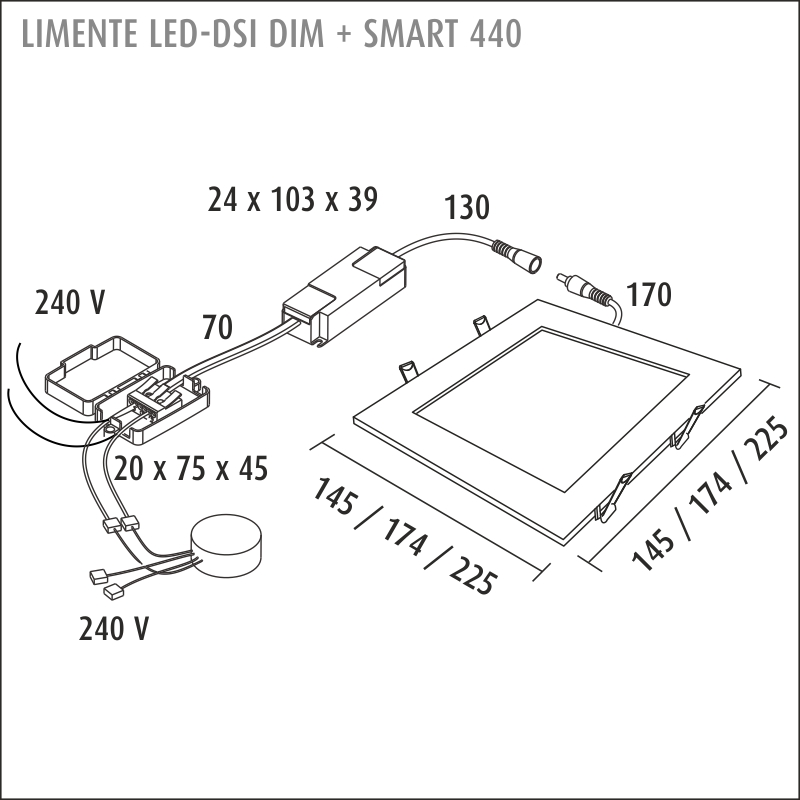
Free Delivery on Eligible Orders! DSI has a digital signal, consisting of 8-bit information, which communicates with the control modules for lighting. DSI is a Tridonic name and can be set up with a variety of control options and controllers, some offered by other manufacturers designed purely to work with the DSI ballast.
Digital Serial Interface ( DSI ) is a protocol for the controlling of lighting in buildings (initially electrical ballasts). DSI ensures that there are no issues with interference from the switching and the dimming of the luminaire which can affect switch on. DSI is wired using a dimming pair, run around to each luminaire in the circuit.
Dimming is often smoother and lower than mains dimming options. It requires a separate ‘control’ cable to be run from the controller to the fittings driver. DSI stands for Digital Series Interface, and is a more controllable version of digital dimming. It enables the user to group It enables the user to group luminaires, operate daylight linked dimming and other controlling options. DSI (digital serial interface) What you would use it for.
Dimming LE fluorescent, halogen or incandescent lights. Like 0–10V dimming, DSI enables hard-wired groups of luminaires to dim collectively. But where 0–10V uses a varying voltage to tell the lights how to dim (the amount of current is roughly equal to the intensity of the light—e.g.
1V = , 5V = and so on), a DSI driver sends digital data to define precise levels of brightness. A dimming control system of some type is normally used to provide the necessary functionality. The DA-SG-4PM-W is a single channel broadcast controller for DALI or DSI devices. The product has the following controls.
Scene buttons: Four buttons that offer 4. PIR occupancy switch with daylight linked dimming for DSI dimmable ballasts Brings lights on – only when area is occupied. This DANLERS range of passive infra-red (PIR) occupancy switches with daylight linked dimming (maintained lux level) is designed for lighting loads controlled by either DSI dimmable ballasts. The controls switch the lights on when the area is occupie and dim or brighten the lights in response to changes in the ambient light - to maintain a chosen lux level.
REMOTE DIMMABLE DRIVERS Luceco dimmable drivers are compatible with DALI Digital, DSI and switch Dim applications. Some installations may use analogue type dimming. Advanced Tridonic Dimmable Driver for use on LED light sources up to 100W.

In any dimming system, the ballasts and controllers must be able to speak the same language. DALI, DSI , switchDIM and Corridor Function, 1-1 dimming. In the case of digital dimming systems, this language is either. The ability to have a different dimming protocol from the main LCM is also useful where, during the fit out, LED lighting may have been installed which is 1-10V and where an existing LCM is either DALI or DSI. The outputs are also individually addressable allowing for maximum flexibility.
Understanding dimming technologies Dimming lamps require a reduction of the power into the device to produce a reduction of the intensity of the light source. In all these situations the AMD panel can be used to provide a local control facility. The level of dimming achievable depends on type of control gear used typical dimming levels are however 0. This feature is not available right now. Thanks to the need for a screened cable - a specialised cable that runs between the controller and the driver - 1-10V multi-point dimming is a bit of a ‘marmite’ commercial multi-point dimming solution.

The digital DSI signal is used to communicate between DSI control modules and digital dimmable DSI ballasts. This is a high quality unit from the Danlers range. The dimming commands consist of 8-bit information, which corresponds to a precise dimmed value. By using a simple dim -up and dim -down function this control recalls programmed lig. Dimmers have fast become a vital part of many lighting applications and installations.
Dimmers allow you to set the level of light and save energy on the output and when teamed with an LED light source, this energy saving can be quite substantial.
No comments:
Post a Comment
Note: only a member of this blog may post a comment.